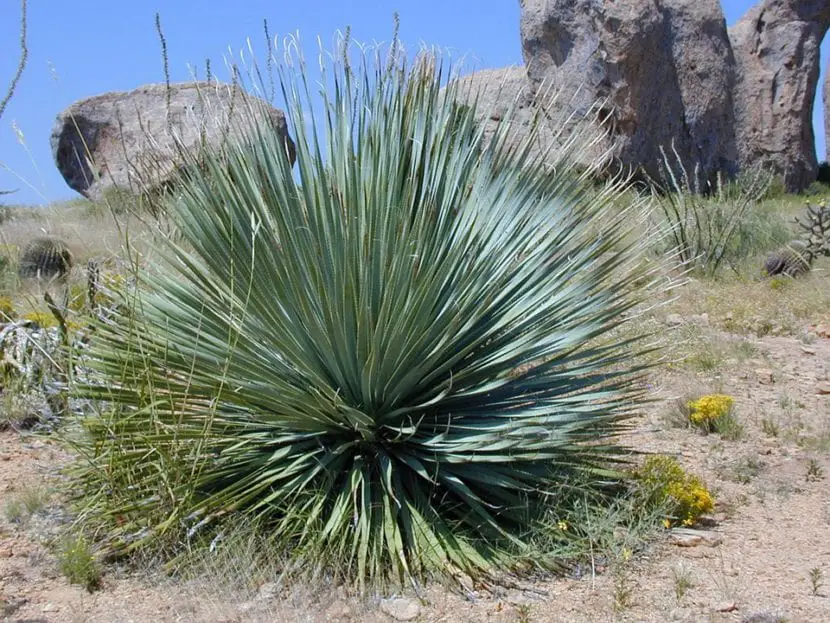
yucca rostrata
It is one of the most resistant plants to drought, if not the most. It can grow in all types of soils, and in an interesting variety of climates, as it supports both mild frosts and extreme high temperatures. Its beautiful leaves are very characteristic: long, thin and pointed, green or bluish-green in color. Your name? Yucca.
Know how it is cared for, the uses it has And much much more in this special about one of the most incredible plants in the world.

yucca glauca
Yucca is a succulent plant that belongs to the botanical genus Yucca, which is composed of about 50 species of the Agavaceae family. It is thus a close family member of the agaves. It is native to North and Central America. Its leaves, as we anticipated before, are thin, sword-shaped.
Most species have a trunk or stem, but there are also those that do not separate much from the ground. The flowers appear grouped in panicle-shaped inflorescences, that is, in the form of a branched clusterand are white. And the fruit is about 2-2,5cm long, fleshy.
Cassava Care

Yucca aloifolia ‘Variegata’
If what you are looking for is an all-terrain plant, resistant to drought and weak frosts, Yuca is one of your best options. We tell you what you need to grow:
Location
It is very important place it in an area where it gets direct sunlightideally throughout the day. If we have it indoors, it must be in a room where a lot of natural light enters, but placed away from the window, since otherwise it would turn its stems itself, being attracted by the light.
Irrigation
Occasional. If it’s in the garden During the first year it is recommended to water it once a week, but from the second it will not matter to water it more than once every 15 or 20 days. I can tell you that where I live, 350l / year fall and the Yuca that are planted take care of themselves.
On the contrary, if it is potted, you have to water once a week, or twice in summer.
Soil or substrate

Yucca reverchonii
It is not demanding at all. It can grow in all types of soilsin the sandy, poor, in the shallow, in the rocky … But if you have it in a pot, you must use a porous substrate, made up of black peat and perlite in equal parts to avoid waterlogging.
Transplant
Whether you want to move to a larger pot or to the garden, it has to be done in springwhen the risk of frost has passed.
Pruning
They have to remove the stems that have already flowered.
Cassava pests and diseases
It is very resistant, but the truth is that it can have problems with mealybugsespecially with the cottony ones, and with the mushrooms if the humidity (in the substrate / soil and / or in the environment) is high. The former can be removed with a swab from the ears soaked in soap and water; for the latter, it is necessary to do treatments with fungicides and reduce the frequency of irrigation.
How does it reproduce?

Would you like to have new copies? If so, you can choose to sow its seeds in spring-summer, or make cuttings in summer. Let’s see how to proceed in each case:
Seeds
Cassava seeds ripen towards the end of summer / early autumn, so I recommend you pick the fruits, remove the shell and clean the seed well so that it remains intact until the good weather returns. Once you do, put it in a glass of water to hydrate it for 24 hours. After, follow this step by step:
- Fill a 20cm diameter pot with porous substrate. A good mix would be 60% river sand with 40% black peat.
- Place the seed right in the center.
- Cover it with substrate.
- Water.
- And finally, place the pot in an area where the sun hits it directly.
Will germinate in 15-20 days.
Cuttings
There are many species from which cuttings can be taken, such as yucca aloifolia or the yucca elephantipes. To do this, simply you have to cut the branch that interests you, and plant it in a pot with porous substrate (It can be the mixture mentioned before, that of 60% river sand with 40% black peat).
Keep the soil slightly moist – but not waterlogged – and in a maximum of three weeks it will begin to emit roots.
Uses of Yuca
It is used above all as ornamental plant in low or no maintenance gardens, but you can also eat the fruits. And speaking of fruits, this plant should not be confused with edible cassava, which is also called Yuca and whose scientific name is manihot esculenta. This is a plant that, unlike our protagonist, does not resist frost.
Yucca Properties

yucca brevifolia
Yuca, especially filamentoushas been used for a long time as laxative, purifying and to combat pain. In addition, the roots and stems soaked in water for two or three days can relieve joint pain, and can even be used to wash your hair.
Another use that has nothing to do with us humans but is also very interesting, is to feed dogs and cats. There are many feeds, especially holistic, that contain extracts of these plants. Improves your health, and also decreases the smell of your stoolwhich is undoubtedly appreciated, especially if you have felines at home.
And so far our special of this wonderful plant. What do you think?

